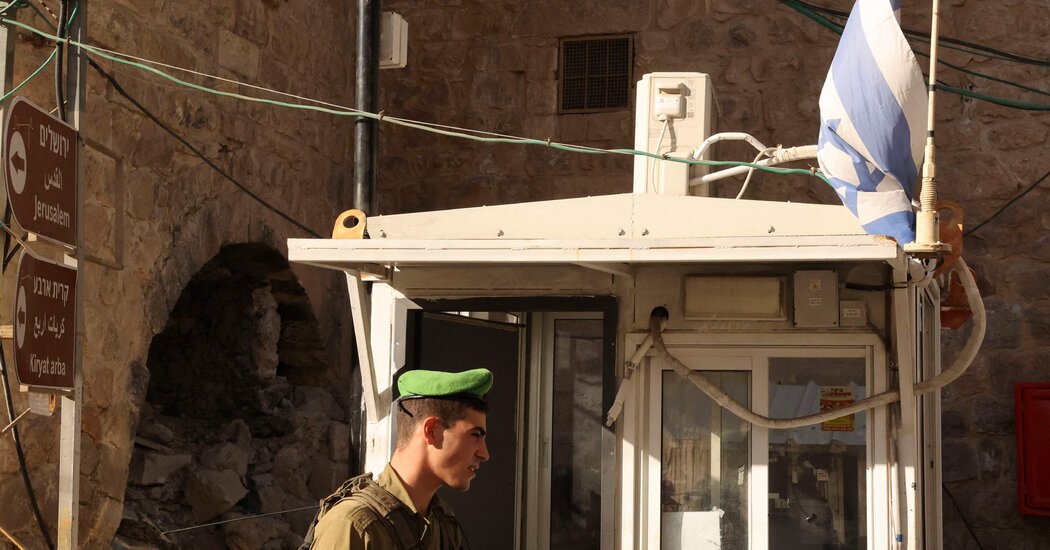Israel is increasingly relying on facial recognition in the occupied West Bank to track Palestinians and restrict their passage through key checkpoints, according to a new report, a sign of how artificial intelligence-powered surveillance can be used against an ethnic group.
At highly fenced checkpoints in Hebron, Palestinians face facial recognition cameras before they are allowed to cross. As their faces are scanned, the software — known as Red Wolf — uses a color-coded system of green, yellow and red to guide soldiers through letting them go, stopping for questioning or arresting them, according to the Amnesty International report. When the technology fails to identify someone, soldiers train the system by adding their personal information to the database.
Israel has long restricted Palestinians’ freedom of movement, but advances in technology give authorities powerful new tools. It is the latest example of the global proliferation of mass surveillance systems, which rely on AI to learn to identify people’s faces from large amounts of images.
In Hebron and East Jerusalem, the technology is targeting Palestinians almost entirely, according to Amnesty’s report, marking a new way to automate the control of internal borders that separate the lives of Palestinians and Israelis. Amnesty called the process “automated apartheid.” Israel has strongly denied that it operates an apartheid regime.
“These databases and tools record exclusively Palestinians’ data,” said the report, which draws on accounts from former Israeli soldiers and Palestinians living in the guarded areas, as well as field visits to observe the use of the technology in affected areas.
The Israel Defense Forces, which plays a central role in the occupied territories of the West Bank, said in a statement that it is “carrying out necessary security and intelligence operations while making significant efforts to mitigate the damage to the routine activities of the Palestinian population.” to a minimum”.
On facial recognition, it added: “Of course we can’t refer to operational and intelligence capabilities.”
Government use of facial recognition technology to so explicitly target a single ethnic group is rare. In China, companies created algorithms that attempted to identify minorities as they passed through the country’s ubiquitous cameras. The Chinese government has also used facial recognition checkpoints to monitor and track the movements of Uighurs, Kazakhs and other ethnic minorities.
Israel’s use of facial recognition at checkpoints builds on other surveillance systems deployed in recent years. Since the protests in the Sheikh Jarrah neighborhood of East Jerusalem over the 2021 eviction of Palestinian families, the presence of cameras in the area has increased, most likely in support of an Israeli government video surveillance system capable of facial recognition, known as Mabat 2000, according to Amnesty. .
While walking through the area, Amnesty researchers reported finding one to two cameras every 4.5 metres. Some are made by Hikvision, the Chinese manufacturer of surveillance cameras, and others by TKH Security, a Dutch manufacturer.
TKH Security refuses to comment. Hikvision did not respond to a request for comment.
Government troops also use the cameras on their phones. According to Breaking the Silence, an organization that supports Amnesty and collects testimonies from Israeli soldiers who have worked in occupied territories, the Israeli authorities have a facial recognition app, Blue Wolf, to identify Palestinians.
Soldiers use the app to photograph Palestinians on the street or during searches to register them in a central database and check whether they are wanted for arrest or questioning, according to the 82-page Amnesty report and testimonials from Breaking the Silence. The use of Blue Wolf was previously reported by The Washington Post.
The surveillance is partly an effort to reduce violence against Israelis. This year, Palestinian attackers have killed 19 Israelis. At least 100 Palestinians have been killed by Israeli security forces this year, many in gunfights that erupted during military operations to apprehend Palestinian gunmen. Israel has occupied the West Bank since 1967 after it was captured from Jordan that year during the Arab-Israeli war.
Issa Amro, a Palestinian activist in Hebron, a West Bank city where violence regularly occurs, said people are under constant surveillance. He, his friends and family are regularly stopped by soldiers from being photographed using the Blue Wolf app. Surveillance cameras line the streets and drones often fly overhead.
Mr Amro said the Israeli army has become so dependent on the automated systems that passing through the checkpoints grinds to a halt if there are technical problems.
“Everything is being watched. My whole life is being watched. I have no privacy,” he said. “I feel like they’re following me everywhere I go.”
Mr Amro said Palestinians are angry that the surveillance tools never seem to be used to identify crimes committed by Israeli settlers against Palestinians.
Ori Givati, a former Israeli tank commander who is now Breaking the Silence’s advocate, said the new surveillance systems were introduced around 2020. The technology has enabled the Israeli government to move towards an automated occupation, he said. Palestinians to constant surveillance and supervision.
The facial recognition systems, he said, are “not only an invasion of privacy, but also a powerful tool for control.”

